Collecting and Reviewing Case Content
Important
Once a case has been created and relevant and necessary tag groups have been identified and created, the user must search the archive based on the custodians that are part of the case. This process is also known as collecting case content.
To know more about searching the archive, refer the Case Management Search when DLM is Disabled section.
To Collect case content, perform the following steps:
In the Collect workspace, users or reviewers have to perform a search to view the documents. The documents do not populate automatically based on a configured case. Once the documents are available in the Collect workspace, users or reviewers can perform the required case actions.
Collecting a case allows you to collect and place conversations on legal hold.
Conversations that are placed on hold are not deleted from the archive even when the applicable retention policies expire.
The conversations are displayed based on the permissions set under Role and Permissions.
If Full Archive Access is set to Allow, case restrictions are not applied and all conversations are displayed. That is, t he Full Archive Access permission overrides the set Case Restriction.
If Full Archive Access is set to Deny and Update Case Restrictions is set to Allow, the conversations are displayed based on the Case Restrictions and Custodian list defined while creating a case.
If both Full Archive Access and Update Case Restrictions are set to Deny, the following error message is displayed while performing a search in the Collect workspace:
Please define Custodians or Case Restrictions for the search to be allowed.If Full Archive Access is set to Deny, ensure that either Update Case Restrictions or View And Update All Cases is set to Allow to view conversations in the Collect workspace.
The actions that can be performed from the Collect workspace are:
|
Export |
Allows the user to export conversations that are listed in the documents panel. Refer Exporting Conversations for more information on how to export a conversation. |
|
Collect Items |
Allows the user to add conversations to a case without placing them on hold. The collected conversations can be identified by the collect icon. |
|
Collect & Apply Holds |
Allows the user to add conversations to the case while placing them on legal hold. |
|
Release Holds |
Allows the user to remove legal hold from conversations. |
|
View Jobs |
Allows the user to view the status of the actions that have been performed from the case management workspace. The following fields are availabe in the jobs status page:
|
To collect a case:
Select the Case Management tab.
To select a case, click the Name & Description of a case listed in the Cases pane. The Case Summary (Overview) of the selected case appears.
Click the Collect link from the Case Management workspace.
Select the Search tab in the Search Archive panel. Refer the Case Management Search when DLM is Disabled section to understand the search functionality.
The search results appear in the Document panel.
The Document panel displays the following information for each conversation listed:
Fields
Description
!
Indicates if the conversation is marked as high importance. If you see the
 icon, it means that the conversation is marked with low importance.
icon, it means that the conversation is marked with low importance.Attachment
Indicates if the conversation has attachment(s) within it. It also displays the number of attachments.
Subject
The subject of the conversation.
From
The person who has sent the mail or initiated the conversation.
To/CC/BCC
Indicates the participants of the conversation
Date
The start date of the conversation.
Network
The network used to communicate.
Channel
The channel used to communicate.

Indicates conversations that have been added to the case.

Indicates documents that have been collected and placed on legal hold.
To select a conversation select the check box against it.
Select one of the following:
Click Collect Items on the Conversations panel, to add conversations for review. You can either add selected items or add all conversations as shown in the following image.
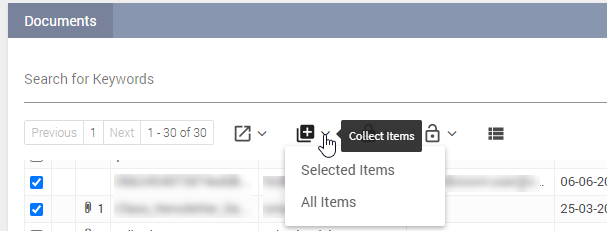
or,
Choose the option Collect and Apply Holds to add conversations to the case and place them on legal hold . You can either hold selected items or hold all conversations as shown in the following image:
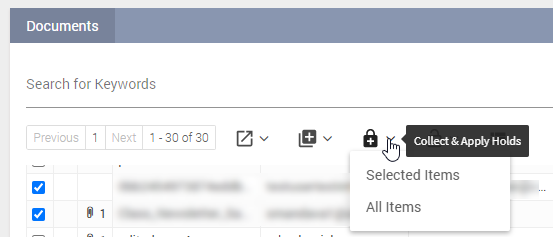
The selected conversation is put on hold and a lock (
 ) is visible under the Hold column for that conversation.
) is visible under the Hold column for that conversation.
To check the status of the conversations that you have put on hold, click the (  ) View jobs icon. The Jobs Status panel appears and displays the status of the actions performed.
) View jobs icon. The Jobs Status panel appears and displays the status of the actions performed.
Important
The count of actual collected documents may differ from the initial search results that was submitted for collection for scenarios such as:
Search results containing duplicate documents.
Disposition has occured while a large collect operation is in progress (> 3 hours).
In such cases, refer the Jobs Status pane for more information regarding failures.
The # of documents total count may fluctuate during a large collect request action. The final accurate count will be updated once the job has been completed.
Removing Conversations from Hold
To remove conversations from hold:
Perform a search for documents that are on hold by enabling Only held conversations filter under Holds in the Search Archive.
Select the documents to be released by clicking the corresponding check box.
Select one of the following:
Click the Release Holds (
 ) icon on Selected Items in the Document panel, to remove selected conversations from hold.
) icon on Selected Items in the Document panel, to remove selected conversations from hold.Click the Release Holds icon on All items to remove all conversations from hold.
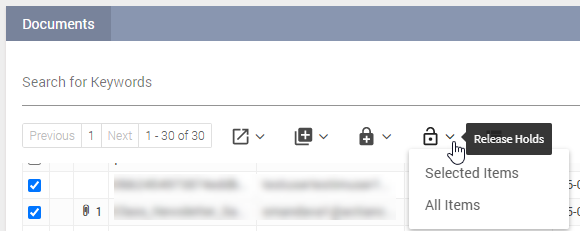
Enterprise Archive allows you to refine search results with respect to participants, networks or communication channels
Important
To Review case content, perform the following steps:
You can review only those cases that are in the collected and collected and held state. Therefore, it is important to collect the cases that need to be reviewed. For procedural details to collect a case, see Collecting Content in Enterprise Archive.
Reviewing a case involves the following processes:
Searching Held, and Collected Conversations
Uncollecting Collected Conversations
Exporting Collected, and Held Conversations
Selecting, Adding Notes, and Tagging a Conversation
Placing Collected Conversations on Hold
Releasing Held Conversations
Searching Held and Collected Conversations
To search held and collected conversations:
Select the Case Management tab.
To select a case, click the Name & Description of a case listed in the My Cases pane. The Case Summary (Overview) of the selected case appears.
Click the Review link from the Case Management workspace.
Select the Search tab in the Search Archive panel. Refer the Case Management Search_OLD section to understand the search functionality.
The search results appear in the Document panel.
The Conversations panel displays the following information for each conversation listed:Fields
Description
!
Indicates if the conversation is marked as high importance. If you see the
 icon, it means that the conversation is marked with low importance.
icon, it means that the conversation is marked with low importance.Attachment
Indicates if the conversation has attachment(s) within it. It also displays the number of attachments.
Subject
The subject of the conversation.
From
The person who has sent the mail or initiated the conversation.
To/CC/BCC
Indicates the participants of the conversation
Sent Time
The actual when the document was sent.
Network
The network used to communicate.
Channel
The channel used to communicate.
Tags
Name of the Tag Groups that have been assigned.
Held
Indicates the document has been placed on Hold from the Collect workspace.
Selecting, Adding Notes, and Tagging a Conversation
To select, add notes and tag a conversation:
Perform the procedure listed in Searching Held and Collected Conversations.
To select a conversation, click the conversation from the Documents pane. View 2 displays the details of the selected conversation.
Type notes for the selected conversation in the Notes text box.
Select the tags for the conversation, from the tag group below the Notes text box.
Click Save. The notes and tags are added to the selected conversation.
Repeat the above steps to add notes and tags to another conversation.
Important
After conversations are put on hold during review and at a later stage, if any of these conversation(s) are selected for Un-Hold during the collect process, the conversations still remain tagged. Tagged conversations filter in the Refine Search tab from the Search panel displays the count including such conversations, however search results do not display these conversations.
Enterprise Archive allows you to refine search results with respect to participants, networks or communication channels. You can also save search results, for more information see Refining Search Results - Case Management.
Bulk Tagging
You can now tag all documents in Review search at once. To perform bulk tagging:
Perform the procedure listed in Searching Held and Collected Conversations.
Navigate to View 2 and on the left pane.
Select the desired tags.
Enable Tag All Search Results under Bulk Tagging.
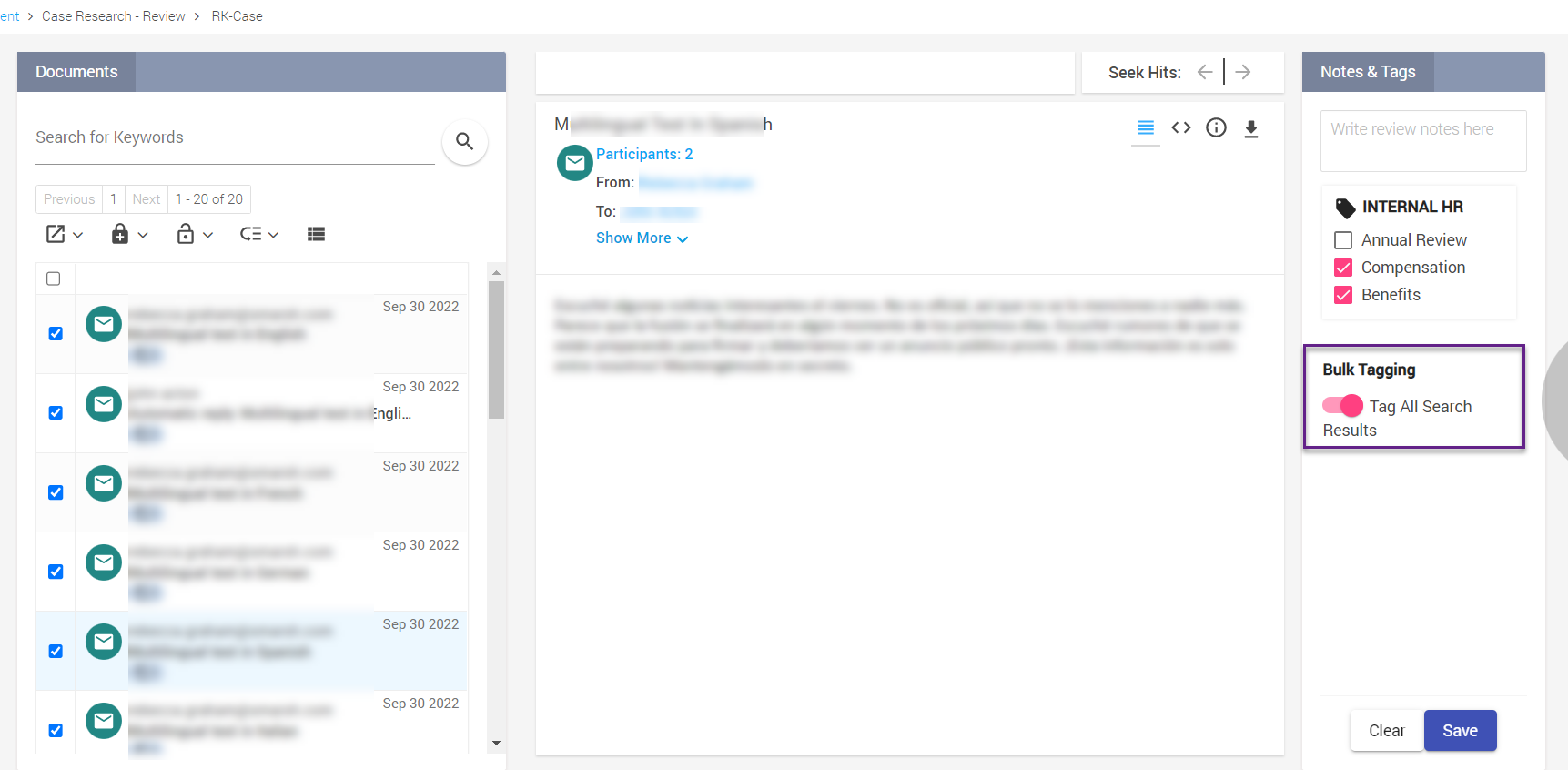
In case you are applying bulk tags to all duplicate content, the UI is slightly different. Enable the Apply To All Content Duplicates under Related Items to apply tags to all duplicate content.
Click Save.
A confirmation dialog appears asking you to confirm the action, click Confirm.

Another dialog appears stating that the Apply Tags request is considered. Navigate to the View Jobs page to view the status.
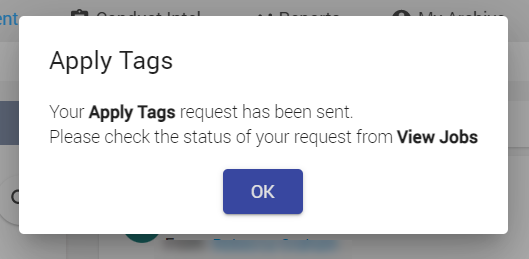
Uncollecting Documents
Important
Uncollect feature is not available by default. Contact Smarsh Support to enable this feature.
To Uncollect documents in the Review page:
In the Review page, perform a search of documents.
Click Uncollect drop-down (
 ) and click All Items.
) and click All Items.The Uncollect operation automatically excludes held documents while providing the count of such documents in the Uncollect pop-up window. If required, such documents may be released from hold before performing an uncollect operation. Choose the following type of documents you wish to uncollect:
Uncollect documents neither on Legal hold nor having Tags/Notes - This option is enabled by default and uncollects documents that are neither on hold nor have any Review Tags or Notes. The count of all such documents are also displayed.
Uncollect documents not on Legal hold but having Tags/Notes - This option is disabled by default to avoid unintentional uncollection of documents that are under review and that are not on hold but are annotated with Review Tags or Notes . The count of all such documents are also displayed. Enable this checkbox to uncollect such documents.
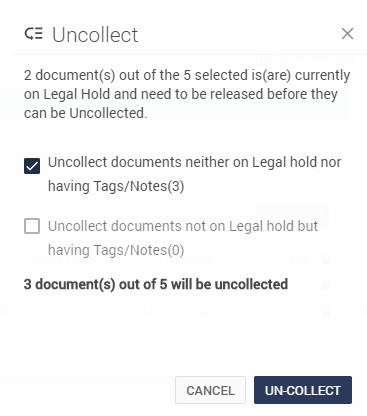
Click UN-COLLECT.
Uncollect submission message appears. Click OK.

Click View Jobs (
 ) to the see the status of the documents.
) to the see the status of the documents.